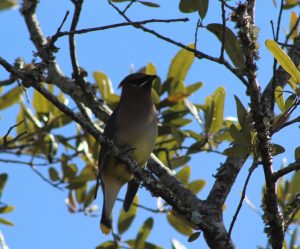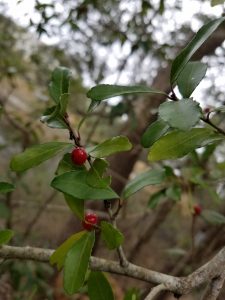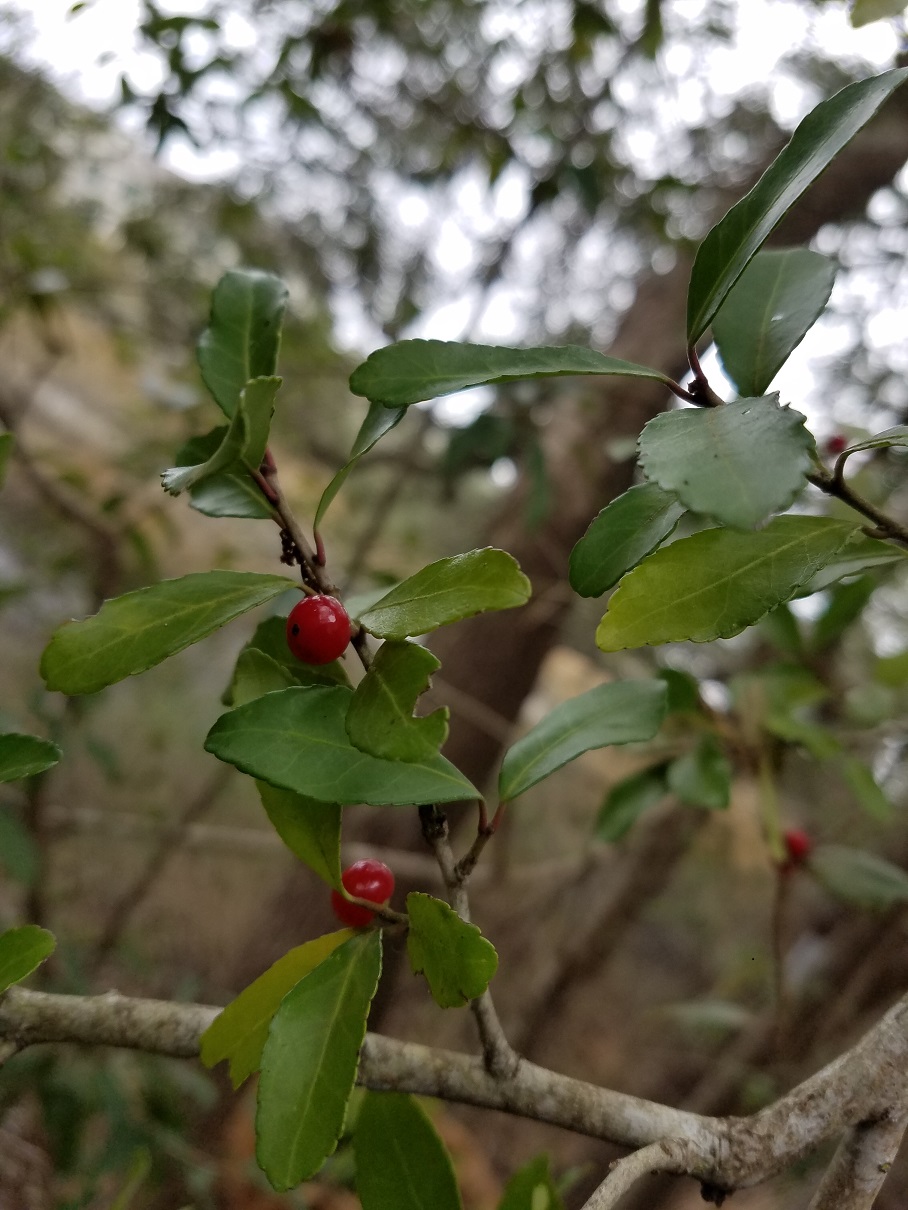 One of the reasons for migrating south is to enjoy eating our meals outside. So, on January 11, 2018, with the temperatures at 68oF, Eileen and I ate lunch on the screened porch of the condo we rent. Everywhere we looked, birds swirled around. We could hear the high pitched (and for those who can hear them) piercing sound of the cedar waxwings, as well as the short chirps of the American robin.
One of the reasons for migrating south is to enjoy eating our meals outside. So, on January 11, 2018, with the temperatures at 68oF, Eileen and I ate lunch on the screened porch of the condo we rent. Everywhere we looked, birds swirled around. We could hear the high pitched (and for those who can hear them) piercing sound of the cedar waxwings, as well as the short chirps of the American robin.
Our third floor vista let us look down on the trees and bushes where we spotted a small tree festooned with deep red berries. My guess is that it was a Yaupon Holly, Ilex vomitoria. The birds covered the bush and as we watched, the tree turned from red with green leaves to just green leaves. By the time we finished lunch, almost every berry was gone.
How is that for a scientific species name—vomitoria! Does not sound like it would be something one would want to eat. According to the Lady Bird Johnson website, the leaves of the plant contain lots of caffeine and Native American made a ceremonial tea from the leaves and twigs. After drinking large quantities of the black tea, they proceeded to vomit the drink back up. The web site does say that while this behavior gave the species name, it apparently is not the holly that caused the vomiting. The web site also explains how the plant keeps its berries until after several frosts. Only then do the birds descend and feast. Today was the day for this bush! [1]
eat. According to the Lady Bird Johnson website, the leaves of the plant contain lots of caffeine and Native American made a ceremonial tea from the leaves and twigs. After drinking large quantities of the black tea, they proceeded to vomit the drink back up. The web site does say that while this behavior gave the species name, it apparently is not the holly that caused the vomiting. The web site also explains how the plant keeps its berries until after several frosts. Only then do the birds descend and feast. Today was the day for this bush! [1]
Some research on the toxicity of the plant produced mixed results, but most sources say that the leaves and stems are good to eat, but few mention the berries. The active ingredient include caffeine and theobromine (an active ingredient in chocolate). The theobromine in chocolate are what make it poisonous to dogs and cats. [2] Doctor of Veterinarian Medicine, Blake Hawley, cautions that birds may be even more susceptible to theobromine, cautioning people not to feed chocolate to their pet birds. Obviously, it is not poisonous to humans! [3]
Want to try yaupon tea? You can find yerba mate tea from Ilex paraguariensis in stores and it is purported to be similar in composition as yaupon tea, which you cannot find in stores. [4]
I was wondering why the birds waited until after the frost. I suspect this plant and other holly’s produce a distasteful chemical that is slowly destroyed either over time or by cold weather. Anyone know a chemist willing to test this hypothesis? Whatever the cause, today was the day the birds “found” this source of food. In addition to the cedar waxwings and the American robins, a yellow-bellied sapsucker samples some of the berries, but was chased away by a northern mockingbird.
During the feeding frenzy, the heavier robins worked the berries from the thicker branches. The lighter cedar waxing could reach berries along the outer edges. The sapsucker would feed hanging upside down. The local red squirrel moved about from tree to tree. It appeared to want to chase the thieves, but there were far too many. Once the berries disappeared down the hundred or so birds gorging themselves, the birds moved down the edge of the marsh. Suddenly in a loud whoosh, they all took off and were gone. I doubt they will return as the food source is now completely depleted.
We not seen any American robins or cedar waxwings in our trees since .
References:
https://www.wildflower.org/plants/result.php?id_plant=ilvo
https://en.wikipedia.org/wiki/Theobromine
http://www.oldworldaviaries.com/text/miscellaneous/toxicoses.html

